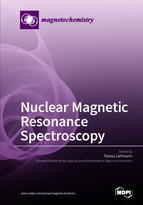Nuclear Magnetic Resonance Spectroscopy
A special issue of Magnetochemistry (ISSN 2312-7481).
Deadline for manuscript submissions: closed (31 October 2017) | Viewed by 111137
Special Issue Editor
Interests: NMR; cancer drugs; malaria; solution structure determination; interfacial phenomena; colloidal dispersion gels
Special Issues, Collections and Topics in MDPI journals
Special Issue Information
Dear Colleagues,
Nuclear Magnetic Resonance (NMR) spectroscopy is a nondestructive technique that can be used to characterize a wide variety of systems. Sustained development of both methodology and instrumentation have allowed NMR to hold a special place as a powerful technology with applications in pure sciences, medicine, drug development, and important branches of industry. NMR provides precise structural information down to each atom and bond in a molecule, and it is the only method for the determination of structures of molecules in solution. NMR can lead to chemical identification and conformational analysis of natural and synthetic chemicals. It is also a powerful technique used in the investigation of polymers in chemistry, and can provide information on the motional properties of molecules and compounds. This Special Issue of the open access journal, Magnetochemistry, devoted to NMR, furnishes researches in the field with the opportunity for authors to publish their most recent discoveries using this exciting technique.
Dr. Teresa Lehmann
Guest Editor
Manuscript Submission Information
Manuscripts should be submitted online at www.mdpi.com by registering and logging in to this website. Once you are registered, click here to go to the submission form. Manuscripts can be submitted until the deadline. All submissions that pass pre-check are peer-reviewed. Accepted papers will be published continuously in the journal (as soon as accepted) and will be listed together on the special issue website. Research articles, review articles as well as short communications are invited. For planned papers, a title and short abstract (about 100 words) can be sent to the Editorial Office for announcement on this website.
Submitted manuscripts should not have been published previously, nor be under consideration for publication elsewhere (except conference proceedings papers). All manuscripts are thoroughly refereed through a single-blind peer-review process. A guide for authors and other relevant information for submission of manuscripts is available on the Instructions for Authors page. Magnetochemistry is an international peer-reviewed open access monthly journal published by MDPI.
Please visit the Instructions for Authors page before submitting a manuscript. The Article Processing Charge (APC) for publication in this open access journal is 2700 CHF (Swiss Francs). Submitted papers should be well formatted and use good English. Authors may use MDPI's English editing service prior to publication or during author revisions.
Keywords
-
Diffusion in porous media
-
Diffusion probes for energy-related macromolecules (surfactants, polymers, organic acids, and asphaltenes)
-
Time-domain NMR
-
NMR applied to polymer dispersion and gels
-
NMR applied to locally ordered protein networks
-
NMR applied to molecular conformation and dynamics
-
Transport imaging
-
NMR in the solid state
-
Relaxometry
-
NMR applied to paramagnetic molecules
-
Characterization of synthetic organic and inorganic molecules through NMR
-
NMR in natural products and pharmaceutical chemistry
-
Structural analysis by two-dimensional NMR
-
Multidimensional NMR in liquids






